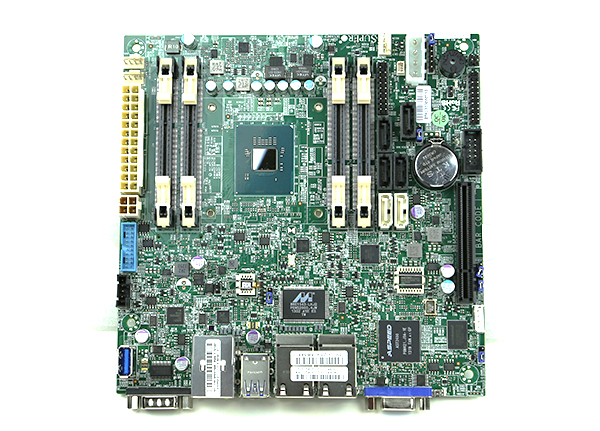Right now I'm actively using the following three computer systems
- NAS: QNAP, Marvell Kirkwood 1.2 GHz ARM running Debian 7, hooked up to a 5-bay eSATA enclosure for my storage needs
- Notebook: IBM Thinkpad T43 (read: IBM not Lenovo), 2GHz Dothan with 2GB RAM, running Windows 8 on an SSD
- Virtualization Server: Intel Pentium 4 Northwood 2.8, 4GB ECC RAM (3992 MB usable), running Debian 7 and VitualBox with headless client VMs
Both the laptop and the server are really pushing it, and I'm not able to virtualize Windows 8 and up on the server (lack of NX), nor 64-bit operating systems. The laptop is fine so far, but it's noisy and I'm not sure how much longer it'll last (its motherboard is notoriously for flex issues leading to breakage of traces and the chipset & ATI X300 often get bad contacts requiring reflowing of their contacts).
My business-provisioned laptop is currently used for all heavy virtualization, as it's a quad-core i7 with 16GB RAM. However, I'd like to upgrade my private systems to provide similar capabilities.
For a while I've been eyeing different options:
1. high-end Haswell notebook for everything (internet/office + virtualization)
or..
2. simple notebook + a small, low-power server for most heavy virtualization needs that stores all VM guest images on the NAS.
I want the notebook to have a good keyboard (no super-short key travel), a good display panel (IPS with no super-reflective glass coating), good battery life and a smaller formfactor than my current notebook (13"-14").
Option 1. then leads me to chose between the new Apple Macbook Pro Retina 13", or a Lenovo Thinpad T440p. However, both don't come cheap, especially not in Europe. I'd be afraid to lose my laptop wherever I take it; especially Apple laptops are a very popular target among thieves. The Apple also does not come with a TPM chip (no playing around with the virtual smart card that Windows NT6.2 and up have), and are difficult to impossible to service yourself (hello expensive repairs!).
Option 2. Allows me to keep using my Thinpad T43 for a while longer, until it really is no longer usable, and then can be replaced by a mid-range model with good IPS panel. Since IPS is getting in fashion again, this should be easier in about a year time. I've been looking at the Lenovo Thinkpad Yoga, and really like its concept; the keyboard and monitor flex is putting me off for the moment though.
As for server components, this is what I've been looking at so far:
Case: MS-Tech CI-70.
mini-itx, very compact, and sufficiently powerful PSU (60W).
Motherboard and CPU:
either the Asrock E3C226D2I + Intel Xeon E3-1230L v3
or the Supermicro X10SLV-Q + Core i7-4765T.
I'd go for 16GB of Crucial 1.35v SO-DIMMs with either option, ECC in case of the Xeon and regular in case of the Core i7.
There might be better ideas out there, and I'm not sure if the Xeon+ECC should be any better than the Core i7+regular RAM. The Northwood server has ECC RAM, and the ECC error detection log in the BIOS has so far detected 0 errors over the many years of operation it has had.
Edit: I've just seen This motherboard with a 8-core ATOM server chip... I'm wondering how it compares to the i7 and Xeon CPUs. The max 64GB RAM (max 32GB realistically with currently available DIMMs) is definitely very nice to have for a server platform. I'm afraid I'd max out the 16GB rather sooner than later with either of the two motherboards listed in my post, even with memory overcommiting. Main question is how does the ATOM cores compare e.g. a Xeon E3-1230Lv3, and if VT-d is available on this platform.
- NAS: QNAP, Marvell Kirkwood 1.2 GHz ARM running Debian 7, hooked up to a 5-bay eSATA enclosure for my storage needs
- Notebook: IBM Thinkpad T43 (read: IBM not Lenovo), 2GHz Dothan with 2GB RAM, running Windows 8 on an SSD
- Virtualization Server: Intel Pentium 4 Northwood 2.8, 4GB ECC RAM (3992 MB usable), running Debian 7 and VitualBox with headless client VMs
Both the laptop and the server are really pushing it, and I'm not able to virtualize Windows 8 and up on the server (lack of NX), nor 64-bit operating systems. The laptop is fine so far, but it's noisy and I'm not sure how much longer it'll last (its motherboard is notoriously for flex issues leading to breakage of traces and the chipset & ATI X300 often get bad contacts requiring reflowing of their contacts).
My business-provisioned laptop is currently used for all heavy virtualization, as it's a quad-core i7 with 16GB RAM. However, I'd like to upgrade my private systems to provide similar capabilities.
For a while I've been eyeing different options:
1. high-end Haswell notebook for everything (internet/office + virtualization)
or..
2. simple notebook + a small, low-power server for most heavy virtualization needs that stores all VM guest images on the NAS.
I want the notebook to have a good keyboard (no super-short key travel), a good display panel (IPS with no super-reflective glass coating), good battery life and a smaller formfactor than my current notebook (13"-14").
Option 1. then leads me to chose between the new Apple Macbook Pro Retina 13", or a Lenovo Thinpad T440p. However, both don't come cheap, especially not in Europe. I'd be afraid to lose my laptop wherever I take it; especially Apple laptops are a very popular target among thieves. The Apple also does not come with a TPM chip (no playing around with the virtual smart card that Windows NT6.2 and up have), and are difficult to impossible to service yourself (hello expensive repairs!).
Option 2. Allows me to keep using my Thinpad T43 for a while longer, until it really is no longer usable, and then can be replaced by a mid-range model with good IPS panel. Since IPS is getting in fashion again, this should be easier in about a year time. I've been looking at the Lenovo Thinkpad Yoga, and really like its concept; the keyboard and monitor flex is putting me off for the moment though.
As for server components, this is what I've been looking at so far:
Case: MS-Tech CI-70.
mini-itx, very compact, and sufficiently powerful PSU (60W).
Motherboard and CPU:
either the Asrock E3C226D2I + Intel Xeon E3-1230L v3
or the Supermicro X10SLV-Q + Core i7-4765T.
I'd go for 16GB of Crucial 1.35v SO-DIMMs with either option, ECC in case of the Xeon and regular in case of the Core i7.
There might be better ideas out there, and I'm not sure if the Xeon+ECC should be any better than the Core i7+regular RAM. The Northwood server has ECC RAM, and the ECC error detection log in the BIOS has so far detected 0 errors over the many years of operation it has had.
Edit: I've just seen This motherboard with a 8-core ATOM server chip... I'm wondering how it compares to the i7 and Xeon CPUs. The max 64GB RAM (max 32GB realistically with currently available DIMMs) is definitely very nice to have for a server platform. I'm afraid I'd max out the 16GB rather sooner than later with either of the two motherboards listed in my post, even with memory overcommiting. Main question is how does the ATOM cores compare e.g. a Xeon E3-1230Lv3, and if VT-d is available on this platform.



 or Aircooling.
or Aircooling. Fractal Design Arc Mini R2, 3800X, Asus B450M-PRO mATX, 2x8GB B-die@3800C16, AMD Vega64, Seasonic 850W Gold, Black Ice Nemesis/Laing DDC/EKWB 240 Loop (VRM>CPU>GPU), Noctua Fans.
Fractal Design Arc Mini R2, 3800X, Asus B450M-PRO mATX, 2x8GB B-die@3800C16, AMD Vega64, Seasonic 850W Gold, Black Ice Nemesis/Laing DDC/EKWB 240 Loop (VRM>CPU>GPU), Noctua Fans.
Comment